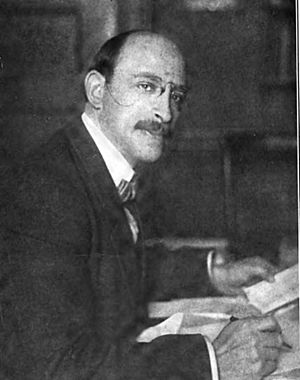Alexander Berkman facts for kids
Quick facts for kids
Alexander Berkman
|
|
|---|---|

Alexander Berkman, September 1912
|
|
| Born |
Ovsei Osipovich Berkman
November 21, 1870 Vilnius, Vilna Governorate, Russian Empire
|
| Died | June 28, 1936 (aged 65) Nice, France
|
| Burial place | Cochez Cemetery, Nice, France |
| Occupation |
|
| Family | Mark Natanson (uncle) |
| Signature | |
Alexander Berkman (November 21, 1870 – June 28, 1936) was a Russian-American anarchist and author. He was a leading member of the anarchist movement in the early 20th century, famous for both his political activism and his writing.
Biography
Berkman was born into a wealthy Jewish family in Vilna in the Russian Empire (present-day Vilnius, Lithuania). He was the youngest of four children born into a well-off Lithuanian Jewish family. Berkman's father, Osip Berkman, was a successful leather merchant, and his mother, Yetta Berkman (née Natanson), came from a prosperous family.
In 1877, Osip Berkman was granted the right, as a successful businessman, to move from the Pale of Settlement to which Jews were generally restricted in the Russian Empire. The family moved to Saint Petersburg, a city previously off-limits to Jews. There, Ovsei adopted the more Russian name Alexander; he was known among family and friends as Sasha, a diminutive for Alexander. The Berkmans lived comfortably, with servants and a summer house. Berkman attended the gymnasium, where he received a classical education with the youth of Saint Petersburg's elite.
Soon after Berkman turned 12, his father died. The business had to be sold, and the family lost the right to live in Saint Petersburg. Yetta moved the family to Kovno, where her brother Nathan lived. Berkman had shown great promise as a student at the gymnasium, but his studies began to falter as he spent his time reading novels. Soon, Berkman joined a group at school that was reading and discussing revolutionary literature, which was prohibited under the new tsar, Alexander III. He distributed banned material to other students and wrote some radical tracts of his own, which he printed using supplies pilfered from the school.
Berkman's mother died in 1887, and his uncle Nathan Natanson became responsible for him. Berkman had contempt for Natanson for his desire to maintain order and avoid conflict. Natanson could not understand what Berkman found appealing in his radical ideas, and he worried that Berkman would bring shame to the family. Late that year, Berkman was caught stealing copies of the school exams and bribing a handyman. He was expelled.
Berkman decided to emigrate to the United States. When his brother left for Germany in early 1888 to study medicine, Berkman took the opportunity to accompany him and from there made his way to New York City.
In New York City he became involved in the anarchist movement. He was the lifelong friend of anarchist Emma Goldman. In 1892, undertaking an act of propaganda of the deed, Berkman made an unsuccessful attempt to assassinate businessman Henry Clay Frick during the Homestead strike, for which he served 14 years in prison. His experience in prison was the basis of his first book, Prison Memoirs of an Anarchist.
After his release from prison, Berkman served as editor of Goldman's anarchist journal, Mother Earth, and later established his own journal, The Blast. In 1917, Berkman and Goldman were sentenced to two years in jail for conspiracy against the newly instated draft. After their release from prison, they were arrested—along with hundreds of others—and deported to Russia. Initially supportive of that country's Bolshevik revolution, Berkman and Goldman soon became disillusioned, voicing their opposition to the Soviets' use of terror after seizing power and their repression of fellow revolutionaries. They left the Soviet Union in late 1921, and in 1925 Berkman published a book about his experiences, The Bolshevik Myth.
While living in France, Berkman continued his work in support of the anarchist movement, producing the classic exposition of anarchist principles, Now and After: The ABC of Communist Anarchism.
Berkman spent his last years eking out a precarious living as an editor and translator. He and his companion, Emmy Eckstein, relocated frequently within Nice in search of smaller and less expensive quarters. Aronstam, who had changed his name to Modest Stein and attained success as an artist, became a benefactor, sending Berkman a monthly sum to help with expenses. In the 1930s his health began to deteriorate, and he underwent two unsuccessful operations for a prostate condition in early 1936. After the second surgery, he was bed-ridden for months. In constant pain, forced to rely on the financial help of friends and dependent on Eckstein's care, Berkman decided to take his own life. He died on June 28, 1936.
Goldman made funeral arrangements for Berkman. It had been his desire to be cremated and have his ashes buried in Waldheim Cemetery in Chicago, near the graves of the Haymarket defendants who had inspired him, but she could not afford the expense. Instead, Berkman was buried in a common grave in Cochez Cemetery in Nice.
Berkman died weeks before the start of the Spanish Revolution, modern history's clearest example of an anarcho-syndicalist revolution. In July 1937, Goldman wrote that seeing his principles in practice in Spain "would have rejuvenated [Berkman] and given him new strength, new hope. If only he had lived a little longer!"
Images for kids
-
Berkman addressing a May Day rally in New York's Union Square, 1914
-
Berkman's experiences in Bolshevist Russia were the basis of The Bolshevik Myth.
-
Berkman (right) and Nestor Makhno in Paris, 1927
See also
 In Spanish: Alexander Berkman para niños
In Spanish: Alexander Berkman para niños








